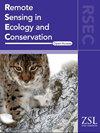Application of computer vision for off‐highway vehicle route detection: A case study in Mojave desert tortoise habitat
IF 4.3
2区 环境科学与生态学
Q1 ECOLOGY
引用次数: 0
Abstract
Driving off‐highway vehicles (OHVs), which contributes to habitat degradation and fragmentation, is a common recreational activity in the United States and other parts of the world, particularly in desert environments with fragile ecosystems. Although habitat degradation and mortality from the expansion of OHV networks are thought to have major impacts on desert species, comprehensive maps of OHV route networks and their changes are poorly understood. To better understand how OHV route networks have evolved in the Mojave Desert ecoregion, we developed a computer vision approach to estimate OHV route location and density across the range of the Mojave desert tortoise (计算机视觉在非公路车辆路线检测中的应用——以莫哈韦沙漠陆龟栖息地为例
在美国和世界其他地区,特别是在生态系统脆弱的沙漠环境中,驾驶非公路车辆(ohv)是一种常见的娱乐活动,它会导致栖息地退化和破碎化。虽然人们认为OHV网络扩张造成的栖息地退化和死亡率对沙漠物种有重大影响,但OHV路线网络的综合地图及其变化却知之甚少。为了更好地了解莫哈维沙漠生态区内OHV路线网络的演变过程,我们开发了一种计算机视觉方法来估计莫哈维沙漠陆龟(Gopherus agassizii)范围内OHV路线的位置和密度。我们将OHV路线定义为非铺设的线性特征,包括指定路线和在非铺设路线存在的清洗。使用当代(n = 1499)和历史(n = 1148)航空图像,我们训练并验证了三个卷积神经网络(CNN)模型。我们在独立整理的数据集上交叉检查了每个模型,并选择了性能最高的模型来生成整个乌龟范围的预测。当对“混合”测试集(n = 1807张图像)进行评估时,最终的混合模型达到了77%的准确率。然后,我们将该模型应用于陆龟范围内的遥感图像,并生成了20世纪70年代、80年代、2010年代和2020年代的OHV路线密度空间层。研究了龟类保护区(TCA)和恢复单元(RU)内的OHV路径密度。结果表明:1980 - 2020年,中国中部地区和中部地区的OHV路径密度均呈上升趋势,分别为8.45%和7.85%;有序逻辑回归显示相关性强(OR = 1.01, P <;0.001),模型输出和研究区域的地面真实OHV图之间存在差异。我们的计算机视觉方法和映射结果可以为保护策略和管理提供信息,旨在减轻OHV活动对敏感生态系统的不利影响。
本文章由计算机程序翻译,如有差异,请以英文原文为准。
求助全文
约1分钟内获得全文
求助全文
来源期刊

Remote Sensing in Ecology and Conservation
Earth and Planetary Sciences-Computers in Earth Sciences
CiteScore
9.80
自引率
5.50%
发文量
69
审稿时长
18 weeks
期刊介绍:
emote Sensing in Ecology and Conservation provides a forum for rapid, peer-reviewed publication of novel, multidisciplinary research at the interface between remote sensing science and ecology and conservation. The journal prioritizes findings that advance the scientific basis of ecology and conservation, promoting the development of remote-sensing based methods relevant to the management of land use and biological systems at all levels, from populations and species to ecosystems and biomes. The journal defines remote sensing in its broadest sense, including data acquisition by hand-held and fixed ground-based sensors, such as camera traps and acoustic recorders, and sensors on airplanes and satellites. The intended journal’s audience includes ecologists, conservation scientists, policy makers, managers of terrestrial and aquatic systems, remote sensing scientists, and students.
Remote Sensing in Ecology and Conservation is a fully open access journal from Wiley and the Zoological Society of London. Remote sensing has enormous potential as to provide information on the state of, and pressures on, biological diversity and ecosystem services, at multiple spatial and temporal scales. This new publication provides a forum for multidisciplinary research in remote sensing science, ecological research and conservation science.
 求助内容:
求助内容: 应助结果提醒方式:
应助结果提醒方式:


